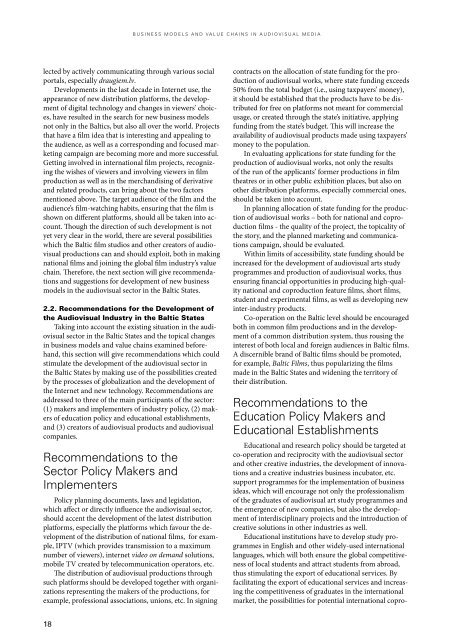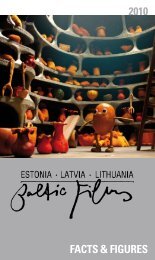Business Models and Value Chains in Audiovisual ... - First Motion
Business Models and Value Chains in Audiovisual ... - First Motion
Business Models and Value Chains in Audiovisual ... - First Motion
Create successful ePaper yourself
Turn your PDF publications into a flip-book with our unique Google optimized e-Paper software.
<strong>Bus<strong>in</strong>ess</strong> <strong>Models</strong> <strong>and</strong> <strong>Value</strong> <strong>Cha<strong>in</strong>s</strong> <strong>in</strong> <strong>Audiovisual</strong> Media<br />
lected by actively communicat<strong>in</strong>g through various social<br />
portals, especially draugiem.lv.<br />
Developments <strong>in</strong> the last decade <strong>in</strong> Internet use, the<br />
appearance of new distribution platforms, the development<br />
of digital technology <strong>and</strong> changes <strong>in</strong> viewers’ choices,<br />
have resulted <strong>in</strong> the search for new bus<strong>in</strong>ess models<br />
not only <strong>in</strong> the Baltics, but also all over the world. Projects<br />
that have a film idea that is <strong>in</strong>terest<strong>in</strong>g <strong>and</strong> appeal<strong>in</strong>g to<br />
the audience, as well as a correspond<strong>in</strong>g <strong>and</strong> focused market<strong>in</strong>g<br />
campaign are becom<strong>in</strong>g more <strong>and</strong> more successful.<br />
Gett<strong>in</strong>g <strong>in</strong>volved <strong>in</strong> <strong>in</strong>ternational film projects, recogniz<strong>in</strong>g<br />
the wishes of viewers <strong>and</strong> <strong>in</strong>volv<strong>in</strong>g viewers <strong>in</strong> film<br />
production as well as <strong>in</strong> the merch<strong>and</strong>is<strong>in</strong>g of derivative<br />
<strong>and</strong> related products, can br<strong>in</strong>g about the two factors<br />
mentioned above. The target audience of the film <strong>and</strong> the<br />
audience’s film-watch<strong>in</strong>g habits, ensur<strong>in</strong>g that the film is<br />
shown on different platforms, should all be taken <strong>in</strong>to account.<br />
Though the direction of such development is not<br />
yet very clear <strong>in</strong> the world, there are several possibilities<br />
which the Baltic film studios <strong>and</strong> other creators of audiovisual<br />
productions can <strong>and</strong> should exploit, both <strong>in</strong> mak<strong>in</strong>g<br />
national films <strong>and</strong> jo<strong>in</strong><strong>in</strong>g the global film <strong>in</strong>dustry’s value<br />
cha<strong>in</strong>. Therefore, the next section will give recommendations<br />
<strong>and</strong> suggestions for development of new bus<strong>in</strong>ess<br />
models <strong>in</strong> the audiovisual sector <strong>in</strong> the Baltic States.<br />
2.2. Recommendations for the Development of<br />
the <strong>Audiovisual</strong> Industry <strong>in</strong> the Baltic States<br />
Tak<strong>in</strong>g <strong>in</strong>to account the exist<strong>in</strong>g situation <strong>in</strong> the audiovisual<br />
sector <strong>in</strong> the Baltic States <strong>and</strong> the topical changes<br />
<strong>in</strong> bus<strong>in</strong>ess models <strong>and</strong> value cha<strong>in</strong>s exam<strong>in</strong>ed beforeh<strong>and</strong>,<br />
this section will give recommendations which could<br />
stimulate the development of the audiovisual sector <strong>in</strong><br />
the Baltic States by mak<strong>in</strong>g use of the possibilities created<br />
by the processes of globalization <strong>and</strong> the development of<br />
the Internet <strong>and</strong> new technology. Recommendations are<br />
addressed to three of the ma<strong>in</strong> participants of the sector:<br />
(1) makers <strong>and</strong> implementers of <strong>in</strong>dustry policy, (2) makers<br />
of education policy <strong>and</strong> educational establishments,<br />
<strong>and</strong> (3) creators of audiovisual products <strong>and</strong> audiovisual<br />
companies.<br />
Recommendations to the<br />
Sector Policy Makers <strong>and</strong><br />
Implementers<br />
Policy plann<strong>in</strong>g documents, laws <strong>and</strong> legislation,<br />
which affect or directly <strong>in</strong>fluence the audiovisual sector,<br />
should accent the development of the latest distribution<br />
platforms, especially the platforms which favour the development<br />
of the distribution of national films, for example,<br />
IPTV (which provides transmission to a maximum<br />
number of viewers), <strong>in</strong>ternet video on dem<strong>and</strong> solutions,<br />
mobile TV created by telecommunication operators, etc.<br />
The distribution of audiovisual productions through<br />
such platforms should be developed together with organizations<br />
represent<strong>in</strong>g the makers of the productions, for<br />
example, professional associations, unions, etc. In sign<strong>in</strong>g<br />
contracts on the allocation of state fund<strong>in</strong>g for the production<br />
of audiovisual works, where state fund<strong>in</strong>g exceeds<br />
50% from the total budget (i.e., us<strong>in</strong>g taxpayers’ money),<br />
it should be established that the products have to be distributed<br />
for free on platforms not meant for commercial<br />
usage, or created through the state’s <strong>in</strong>itiative, apply<strong>in</strong>g<br />
fund<strong>in</strong>g from the state’s budget. This will <strong>in</strong>crease the<br />
availability of audiovisual products made us<strong>in</strong>g taxpayers’<br />
money to the population.<br />
In evaluat<strong>in</strong>g applications for state fund<strong>in</strong>g for the<br />
production of audiovisual works, not only the results<br />
of the run of the applicants’ former productions <strong>in</strong> film<br />
theatres or <strong>in</strong> other public exhibition places, but also on<br />
other distribution platforms, especially commercial ones,<br />
should be taken <strong>in</strong>to account.<br />
In plann<strong>in</strong>g allocation of state fund<strong>in</strong>g for the production<br />
of audiovisual works – both for national <strong>and</strong> coproduction<br />
films - the quality of the project, the topicality of<br />
the story, <strong>and</strong> the planned market<strong>in</strong>g <strong>and</strong> communications<br />
campaign, should be evaluated.<br />
With<strong>in</strong> limits of accessibility, state fund<strong>in</strong>g should be<br />
<strong>in</strong>creased for the development of audiovisual arts study<br />
programmes <strong>and</strong> production of audiovisual works, thus<br />
ensur<strong>in</strong>g f<strong>in</strong>ancial opportunities <strong>in</strong> produc<strong>in</strong>g high-quality<br />
national <strong>and</strong> coproduction feature films, short films,<br />
student <strong>and</strong> experimental films, as well as develop<strong>in</strong>g new<br />
<strong>in</strong>ter-<strong>in</strong>dustry products.<br />
Co-operation on the Baltic level should be encouraged<br />
both <strong>in</strong> common film productions <strong>and</strong> <strong>in</strong> the development<br />
of a common distribution system, thus rous<strong>in</strong>g the<br />
<strong>in</strong>terest of both local <strong>and</strong> foreign audiences <strong>in</strong> Baltic films.<br />
A discernible br<strong>and</strong> of Baltic films should be promoted,<br />
for example, Baltic Films, thus populariz<strong>in</strong>g the films<br />
made <strong>in</strong> the Baltic States <strong>and</strong> widen<strong>in</strong>g the territory of<br />
their distribution.<br />
Recommendations to the<br />
Education Policy Makers <strong>and</strong><br />
Educational Establishments<br />
Educational <strong>and</strong> research policy should be targeted at<br />
co-operation <strong>and</strong> reciprocity with the audiovisual sector<br />
<strong>and</strong> other creative <strong>in</strong>dustries, the development of <strong>in</strong>novations<br />
<strong>and</strong> a creative <strong>in</strong>dustries bus<strong>in</strong>ess <strong>in</strong>cubator, etc.<br />
support programmes for the implementation of bus<strong>in</strong>ess<br />
ideas, which will encourage not only the professionalism<br />
of the graduates of audiovisual art study programmes <strong>and</strong><br />
the emergence of new companies, but also the development<br />
of <strong>in</strong>terdiscipl<strong>in</strong>ary projects <strong>and</strong> the <strong>in</strong>troduction of<br />
creative solutions <strong>in</strong> other <strong>in</strong>dustries as well.<br />
Educational <strong>in</strong>stitutions have to develop study programmes<br />
<strong>in</strong> English <strong>and</strong> other widely-used <strong>in</strong>ternational<br />
languages, which will both ensure the global competitiveness<br />
of local students <strong>and</strong> attract students from abroad,<br />
thus stimulat<strong>in</strong>g the export of educational services. By<br />
facilitat<strong>in</strong>g the export of educational services <strong>and</strong> <strong>in</strong>creas<strong>in</strong>g<br />
the competitiveness of graduates <strong>in</strong> the <strong>in</strong>ternational<br />
market, the possibilities for potential <strong>in</strong>ternational copro-<br />
18
















